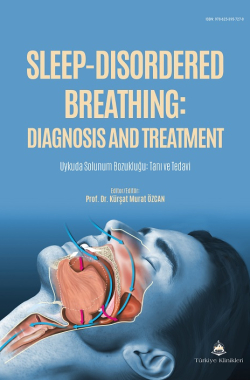DRUG-INDUCED SLEEP ENDOSCOPY
Mehmet Fatih Çakmak
Ordu University Training and Research Hospital, Department of Otorhinolaryngology, Ordu, Türkiye
Çakmak MF. Drug-Induced Sleep Endoscopy. In: Özcan KM, editor. Sleep-Disordered Breathing: Diagnosis and Treatment. 1st ed. Ankara: Türkiye Klinikleri; 2025. p.129-135.
ABSTRACT
Drug-Induced Sleep Endoscopy is a modern and effective diagnostic tool used to evaluate dynamic obstructions of the upper airway in patients with obstructive sleep apnea. Traditional endoscopic examinations conducted during wakefulness often fail to accurately reflect the physiological changes occurring during sleep and may lead to incorrect plans regarding the type of surgical intervention. Drug-Induced Sleep Endoscopy, by simulating natural sleep through pharmacologically induced sedation, allows for direct observation of airway collapse and obstructive events in the upper airways. The method was first introduced in 1978 during natural sleep, however now it is performed under sedation using agents such as propofol and midazolam. Standardization efforts, particularly through European consensus reports published in 2014 and updated in 2017, have helped define the procedure’s indications, contraindications, sedation protocols, patient positioning, technical requirements, and safety standards. Drug-Induced Sleep Endoscopy is particularly recommended for patients who are non-compliant with Positive Airway Pressure or Mandibular Advancement Device therapy, and for those with persistent symptoms following surgical interventions. However, nowadays more and more surgeons have been practicing Drug-Induced Sleep Endoscopy even before primary surgery for obstructive sleep apnea. Drug-Induced Sleep Endoscopy also provides valuable insights into the site and pattern of airway obstruction, supporting personalized treatment strategies. Absolute contraindications include high anesthesia risk (ASA IV), pregnancy, and known allergies to sedative agents. The VOTE (Velum, Oropharynx, Tongue base, Epiglottis) classification system offers a standardized approach for evaluating the degree (none, partial, complete) and configuration (anteroposterior, lateral, concentric) of obstruction observed during Drug-Induced Sleep Endoscopy. Critical factors during the procedure include patient positioning, the dosage of sedatives used, depth of sedation, and real-time monitoring of physiological parameters to ensure procedural safety and validity. In conclusion, Drug-Induced Sleep Endoscopy enables detailed anatomical and functional assessment of upper airway obstructions in obstructive sleep apnea patients, improving diagnostic accuracy and contributing to the development of individualized treatment plans.
Keywords: Sleep apnea (obstructive); Continuous positive airway pressure (CPAP); Palate (soft), Oropharynx; Epiglottis, Palatine tonsil
Kaynak Göster
Referanslar
- Drug-Induced Sleep Endoscopy: Diagnostic and Therapeutic Applications (N. de. Vries, Ottavio. Piccin, O. M. Vanderveken, & Claudio. Vicini, Et al.).2021:1-3. [Crossref]
- Borowiecki B, Pollak CP, Weitzman ED, Rakoff S, Imperato J. Fibro-optic study of pharyngeal airway during sleep in patients with hypersomnia obstructive sleep-apnea syndrome. Laryngoscope. 1978;88(8 Pt 1):1310-3. [Crossref]
- Rojewski TE, Schuller DE, Clark RW, Schmidt HS, Potts RE. Videoendoscopic determination of the mechanism of obstruction in obstructive sleep apnea. Otolaryngol Head Neck Surg. 1984;92(2):127-31. [Crossref] [PubMed]
- Croft CB, Thomson HG, Samuels MP, Southall DP. Endoscopic evaluation and treatment of sleep-associated upper airway obstruction in infants and young children. Clin Otolaryngol Allied Sci. 1990;15(3):209-16. [Crossref] [PubMed]
- Pringle MB, Croft CB. A comparison of sleep nasendoscopy and the Muller manoeuvre. Clin Otolaryngol Allied Sci. 1991;16(6):559-62. [Crossref] [PubMed]
- Pringle MB, Croft CB. A grading system for patients with obstructive sleep apnoea--based on sleep nasendoscopy. Clin Otolaryngol Allied Sci. 1993;18(6):480-4. [Crossref] [PubMed]
- De Vito A, Carrasco Llatas M, Vanni A, Bosi M, Braghiroli A, Campanini A, de Vries N, Hamans E, Hohenhorst W, Kotecha BT, Maurer J, Montevecchi F, Piccin O, Sorrenti G, Vanderveken OM, Vicini C. European position paper on drug-induced sedation endoscopy (DISE). Sleep Breath. 2014;18(3):453-65. [Crossref] [PubMed]
- De Vito A, Carrasco Llatas M, Ravesloot MJ, Kotecha B, De Vries N, et al. European position paper on drug-induced sleep endoscopy: 2017 Update. Clin Otolaryngol. 2018;43(6):1541-1552. [Crossref] [PubMed]
- Certal VF, Pratas R, Guimarães L, Lugo R, Tsou Y, Camacho M, Capasso R. Awake examination versus DISE for surgical decision making in patients with OSA: A systematic review. Laryngoscope. 2016;126(3):768-74. [Crossref] [PubMed]
- Civelek S, Emre IE, Dizdar D, Cuhadaroglu C, Eksioglu BK, Eraslan AK, Turgut S. Comparison of conventional continuous positive airway pressure to continuous positive airway pressure titration performed with sleep endoscopy. Laryngoscope. 2012;122(3):691-5. [Crossref] [PubMed]
- Carrasco-Llatas M, Matarredona-Quiles S, De Vito A, Chong KB, Vicini C. Drug-Induced Sleep Endoscopy: Technique, Indications, Tips and Pitfalls. Healthcare (Basel). 2019 Jul 24;7(3):93. [Crossref] [PubMed] [PMC]
- Charakorn N, Kezirian EJ. Drug-Induced Sleep Endoscopy. Otolaryngol Clin North Am. 2016;49(6):1359-1372. [Crossref] [PubMed]
- Doherty LS, Nolan P, McNicholas WT. Effects of topical anesthesia on upper airway resistance during wake-sleep transitions. J Appl Physiol (1985). 2005;99(2):549-55. [Crossref] [PubMed]
- Safiruddin F, Koutsourelakis I, de Vries N. Upper airway collapse during drug induced sleep endoscopy: head rotation in supine position compared with lateral head and trunk position. Eur Arch Otorhinolaryngol. 2015;272(2):485-8. [Crossref] [PubMed]
- Shteamer JW, Dedhia RC. Sedative choice in drug-induced sleep endoscopy: A neuropharmacology-based review. Laryngoscope. 2017;127(1):273-279. [Crossref] [PubMed]
- Gündüz Ö, Özcan KM, Kundi FCS, Erkılıç E, Fırat S. Determination of optimal sedation depth in sleep endoscopy with bispectrometry and simultaneous polysomnography. Eur Arch Otorhinolaryngol. 2025;282(4):2141-2148. [Crossref] [PubMed]
- Kezirian EJ, Hohenhorst W, de Vries N. Drug-induced sleep endoscopy: the VOTE classification. Eur Arch Otorhinolaryngol. 2011;268(8):1233-1236. [Crossref] [PubMed]

